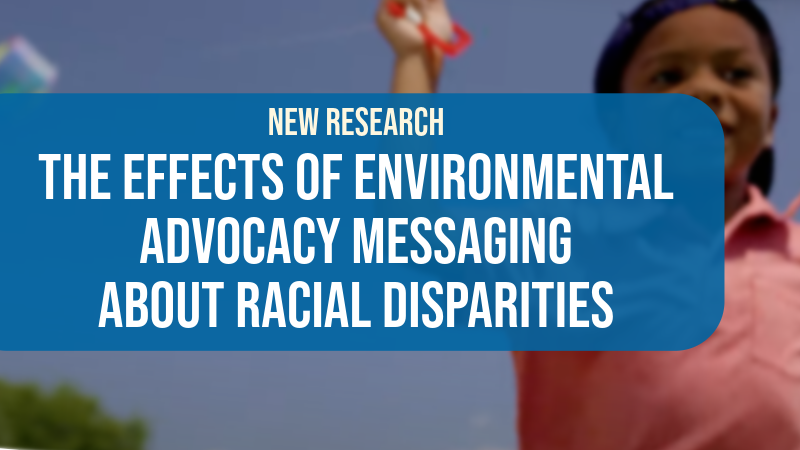Walking a tightrope: The effects of environmental advocacy messaging about racial disparities
February 2, 2024

By Chris Skurka and Cassandra Troy, Penn State; and Rainer Romero-Canyas and Helen Joo, Environmental Defense Fund
Air pollution is a global health problem, responsible for millions of premature deaths each year.
Yet air pollution does not impact all communities equally in the United States. Compared to white individuals, Black individuals have greater exposure to particulate pollution, putting them at greater risk for premature death. Black children in particular suffer disproportionately from asthma and asthma-related deaths.
In light of these concerning facts, the Environmental Defense Fund (EDF), an environmental advocacy group, has turned its attention to public communication strategies. These strategies raise awareness of racial disparities in the harms of air pollution and promote clean air solutions among stakeholders.
To what extent is EDF’s messaging effective at achieving these goals? Moreover, because strategic communications must compete for attention in the crowded media landscape, to what extent is this messaging able to cut through the noise and reach key stakeholders?
We recruited nearly 1,800 U.S. adults for a web-based experiment designed to answer these questions.
Some participants were assigned to watch an EDF-produced video that conveyed how and why air pollution is more damaging to Black children than white children. These participants were either told that they would watch a video about racial disparities or a video about children’s health (a more neutral framing of the issue). Other participants served as a control group and watched videos about air pollution that didn’t mention health effects.
In a separate part of the experiment, we allowed some participants to choose which video they would like to watch. This gave us a window into the demographic and psychological factors that predict whether people are going to opt into this messaging at all.
Our findings yielded three key insights.
First, EDF’s messaging can be effective at changing beliefs. Compared to participants who viewed the control videos, those who viewed the EDF video were more likely to agree that Black children are at greater risk for air pollution effects than white children—what we call “relative risk perception.”
However, this effect differed for Black and non-Black participants depending on how the video was described to participants. It was only when we described the EDF video explicitly as a message about racial disparities (not childhood health) that the effect emerged for both Black and non-Black participants. For Black participants, the EDF video produced similar levels of belief that Black children are at greater risk than White children no matter the description.

Second, the EDF video—regardless of how it was described—strengthened the importance of risk beliefs for persuasion. In other words, the perception of risk to Black children was more likely to translate into support for clean air policies and intentions to engage in activism among participants who watched the EDF video (vs. the control videos). Media effects researchers call this a media priming effect. This means that even though EDF’s messaging didn’t have a direct effect on persuasion, the messaging nevertheless has important psychological implications for pro-environmental outcomes.
Third, only certain groups may be tuning into disparity-focused environmental messaging. Individuals most interested in watching a video purportedly about disparities tended to be younger, Black, and concerned about environmental justice. By contrast, individuals most interested in watching a video purportedly about children’s health tended to be younger and Christian.
All in all, our findings suggest there may be a tension in strategic communication about racial disparities. On one hand, explicitly framing environmental health impacts as a matter of racial inequality most effectively boosts relative risk perceptions across racial groups. On the other hand, this same disparity framing may be “preaching to the choir,” only drawing the attention of stakeholders already interested in the issue.
How might environmental advocacy groups like EDF navigate this tension? It may be worth taking a “trojan horse” approach—that is, embedding explicit discussion about racial disparities toward the end of the message and initially framing the message in language more appealing to a broad audience to enhance exposure. It could also be worth using creative messaging approaches known to be effective at increasing attention to the information, such as telling stories or featuring trusted spokespeople. Future research should explore these possibilities.
Given that different groups gravitate toward the information depending on how the message is framed, strategic communicators should use targeted messaging strategies known to be effective for that group. For example, because our data suggest Christian stakeholders are especially interested in messaging framed around children’s health, that messaging could be designed to emphasize values cherished by Christians, such as stewardship and generosity to others.
At the very least, our findings provide some evidence that messaging about racial inequalities in environmental risk—like that disseminated by EDF—is on the right track. But strategic environmental communicators will need to seriously consider how they might best engage stakeholders’ attention so the message doesn’t get lost in the mix.
For further information on this research, please email Skurka at cjs7142@psu.edu. This project is supported by the 2022 Page/Johnson Legacy Scholar Grant on sustainability.

